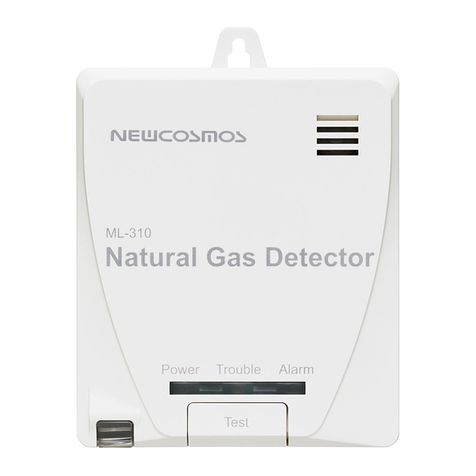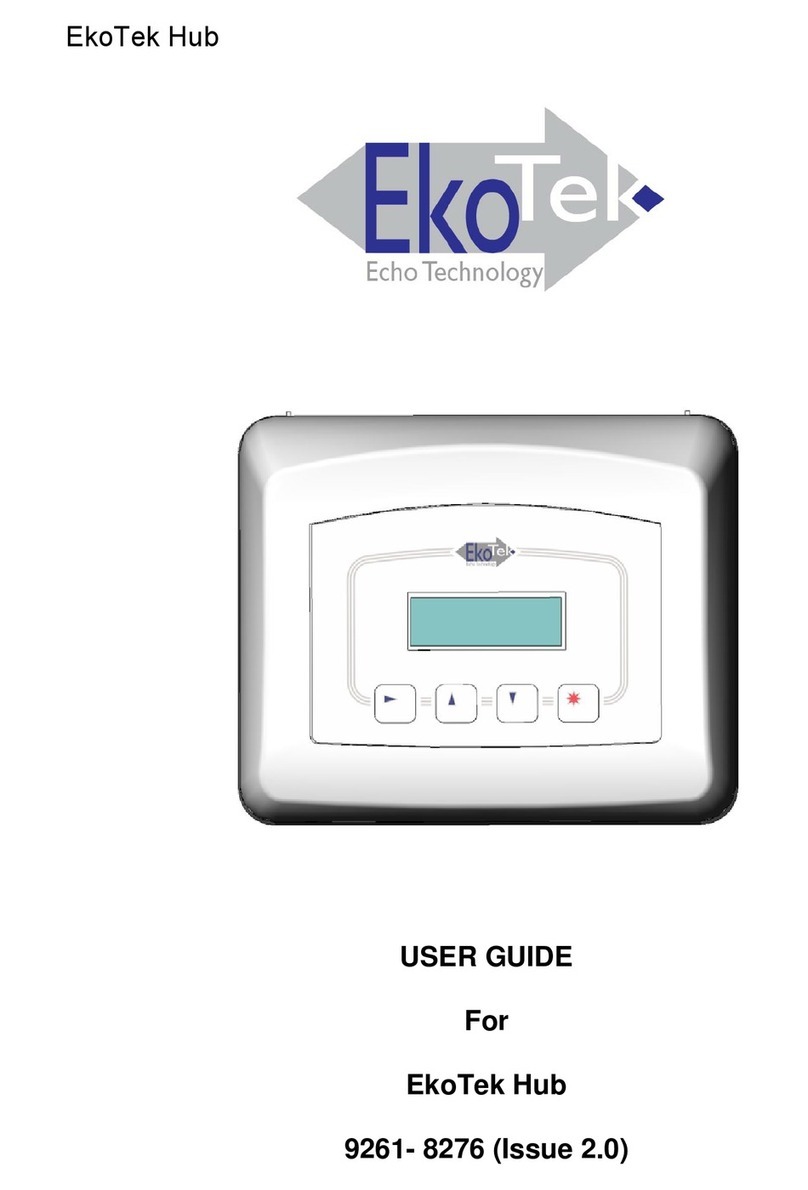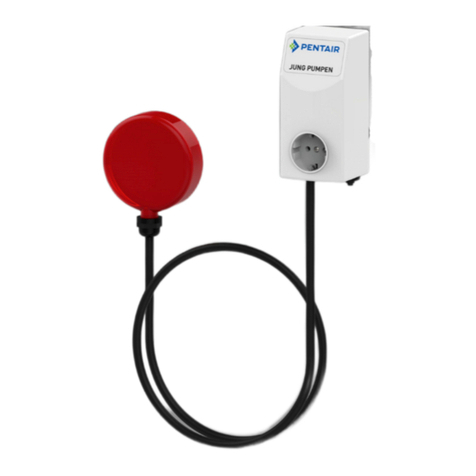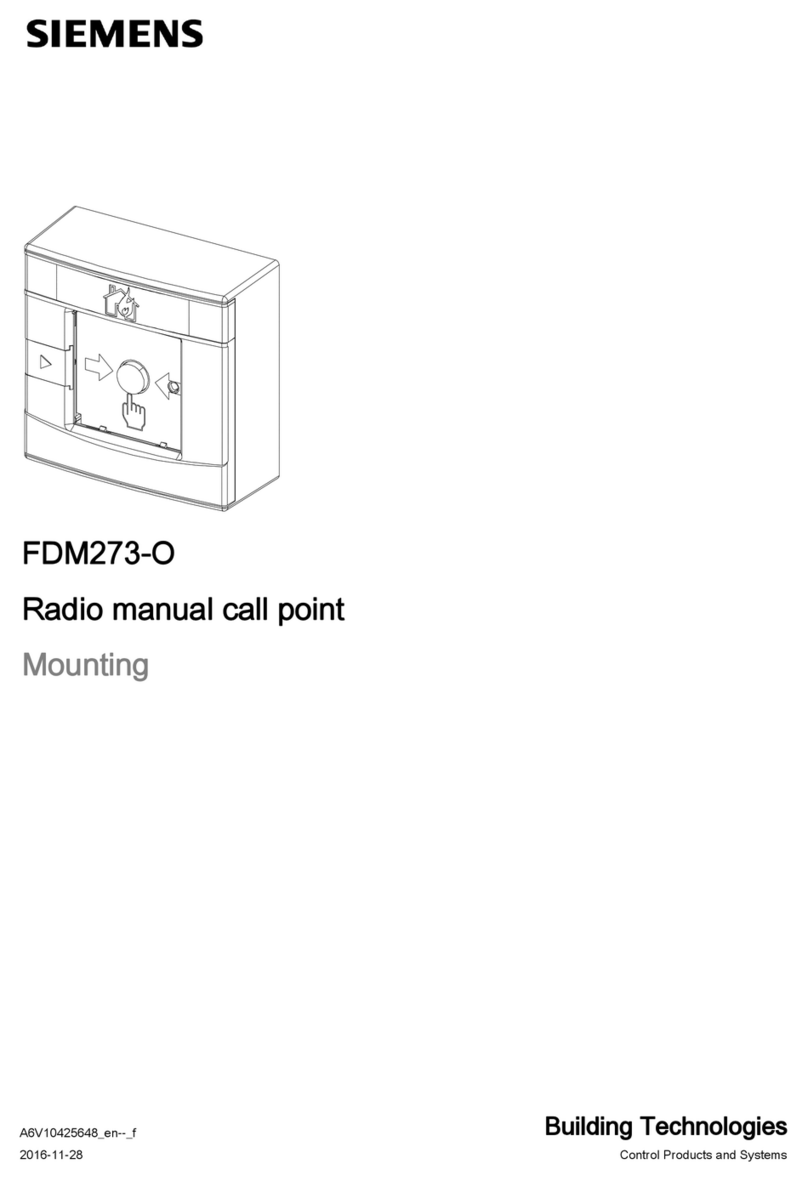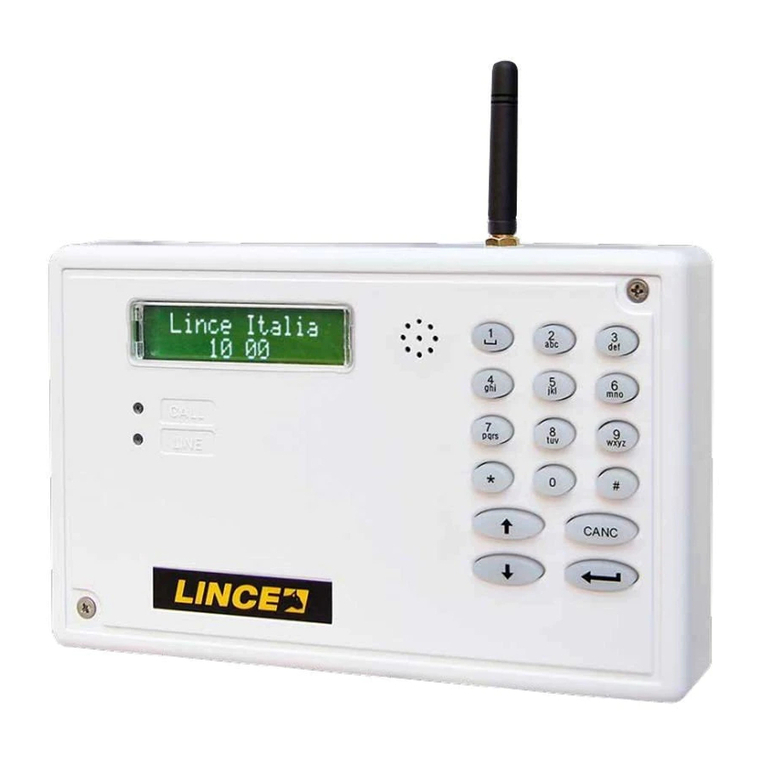New Cosmos Electric NV-100S User manual

1 Point type Oxygen Detection /
Alarm System
Model NV-100S
Instruction Manual
Keep this instruction manual where it is readilyaccessible.
Thoroughlyread this instructionmanual before using the equipment so it can be used safelyand correctly.
New Cosmos Electric Co., Ltd.
Instructionmanual No.
GAE-015
December 2003

Table of Contents
1. Introduction.....................................................................................................................................................................................
2. Safe Operation...............................................................................................................................................................................
3. Unpacking.......................................................................................................................................................................................
4. System Structure............................................................................................................................................................................
5. Dimensions and Part Names........................................................................................................................................................
5-1 Indicator andAlarm Unit.......................................................................................................................................................
5-2 Gas Detector.........................................................................................................................................................................
6. Installation andWiring....................................................................................................................................................................
6-1 How to Install the Indicator andAlarm Unit..........................................................................................................................
6-2 Howto Install the GasDetector...........................................................................................................................................
6-3 Wiring Method.......................................................................................................................................................................
7. Operating Instructions................................................................................................................................................................
7-1 Notes to Users..................................................................................................................................................................
7-2 Procedures........................................................................................................................................................................
7-3 Operation of the Equipment.............................................................................................................................................
7-4 When anAlarm Occurs....................................................................................................................................................
7-5 How to Replace Batteries (when the equipment has a backup power source)............................................................
7-6 Maintenance Functions....................................................................................................................................................
8. Maintenance and Inspections ...................................................................................................................................................
9. Troubleshooting..........................................................................................................................................................................
10. Specifications..............................................................................................................................................................................
10-1 Indicator andAlarm Unit...................................................................................................................................................
10-2 Gas Detector.....................................................................................................................................................................
11. ConsumableParts and Spare Parts.........................................................................................................................................
12. Warranty.....................................................................................................................................................................................
13. Service Life.................................................................................................................................................................................
14. Glossary......................................................................................................................................................................................

--
1. Introduction
Thank you for purchasing an NV-100S single-point oxygen detection/alarm system.
This safety device is used to monitor oxygen concentration. It indicates oxygen leakage and oxygen deficiency by alarm
lamps and an alarm sound when the concentration reaches a preset level.
Thoroughly read this instruction manual before using the equipment so it can be used correctly. Read the instruction
manual of a gas detector as well.
Symbols
The following symbols are used for safety purposes:
: Indicates an imminentlyhazardous situation which, if not avoided, will result in death or serious
injury.
: Indicates a potentially hazardous situation which, if not avoided, will result in death or serious
injury.
: Indicates a potentially hazardous situation which, if not avoided, may result in minor injury or
moderate injury. It mayalso be used to alert against unsafe practices.
: Operational advice and or instruction.
2. Safe Operation
Carefullyread the following so you can use the equipment correctly.
Read and understand all applicable laws and regulations and ensure that you are in complete compliance with the laws and
regulations before installing or operating the equipment.
Installing, wiring, and other works concerning the equipment should be carried out by qualified persons, following all
applicable federal, state, and local health and safetylaws and regulations including OSHA.
WARNING
MEMO
CAUTION
DANGE
R
Operation checks using actual gas are very dangerous because combustible gas may explode and toxic gas is
harmful. An inspection must be carried out beforehand by persons with sufficient expertise or our service staff.
DANGER
Ground the equipment in order to prevent electric shocks.
In case of an alarm, carryout your predetermined measures for gas leakage.
This equipment is not explosion-proof. Install it in a non-hazardous area.
WARNING
Do not dissemble, alter the equipment, or change its structure and electric circuit. It may affec
t
performance of the equipment.
If you control an interlock of external equipment etc. with equipment’s output signal, we are not responsibl
e
for anyinjuries or damages caused byit.
The equipment is not waterproof. Install it in a place where it will not get wet.
Follow all related laws and regulations when using the equipment.
Do not use any equipment that generates electrical noises such as cellular phones or radio-communication
s
within 30 cm of the alarm panel.
CAUTION

--
3. Unpacking
The following standard components are packed together with the oxygen detector/alarm. Carefully check the contents
against the list when unpacking. If any components are missing or damaged, contact our dealer or agency. We will
deliver or replace the components.
NV-100S main body 1
Gas detector head 1
Without a backup power source 1Fuse 1A With a backup power source 2
Parts to embed in a panel (panel-embedded type only) 1
NV-100S instruction manual (this book) 1
Test results of the equipment 1
Warranty 1
Option (separately sold)
Rainproof cover KW-31 for a diffusion type gas detector head KS-2O 1

--
4. System Structure
This equipment consists of a part that detects gas (gas detector head) and a part that indicates gas concentration and sets
off an alarm (indicator and alarm unit). The parts are connected bycables.
Fig. 1 System Structure
The indicator and alarm unit is not an explosion-proof construction. Install it in a non-hazardous area.
CAUTION
One gas detector (either diffusion or suction type gas detector) can be connected. Use a rainproof cove
r
(option) if you install the equipment outdoor.
The number of cores of cables differs according to the gas detector head connected.
MEMO
NV-100S
Indicator
and alarm
unit
Suction type
gas detector
head
PS-2OP
Diffusion type
gas detector
head
KS-2O
Control
device
Power source
AC100/200V
(
DC24V
)
Alarm
contact 2C shielded cable
2C shielded cable
2C cable

--
5. Dimensions and Part Names
5-1 Indicator and Alarm Unit
Fig. 2 Dimensions of the Indicator and Alarm Unit (without a backuppower source)
Fig. 3 Dimensions of the Indicator andAlarm Unit (with a backup power source)

--
5-2 Gas Detector
Refer to the gas detector’s instructionmanual for its dimensions.
No. Name Function
1 Gas concentration indicator This LCD bar graph meter with backlight indicates gas concentration and the
preset alarm value.
2Powerlamp(POWER) It is green during normal operation and orange on a sensor failure. It blinks
green when the equipment is turned on and also after a failure has been taken
care of to show that the equipment is warming up.
3 Alarm lamp (ALARM) A red lamp blinks to indicate oxygen leakage and oxygen deficiency and lights
up when the buzzer stops.
4Buzzer stop key
(BZ STOP) When this key is pressed, the alarm sound stops and the blinking Alarm lamp
lights up.
5 Reset key (RESET) When this key is pressed after the buzzer stops and the reading goes back to a
normal value, the Alarm lamp goes off. It does not go off when the key is
pressed before the buzzer stops.
6 Alarm setting key ( )Use these keys to change the preset alarm value. Press to increase the
set value and press to decrease it.
7 Backup lamp (BACKUP) It is off in normal state and it blinks red during a power failure. (Equipment with
an optional backup power source only.)
8 Message window Displays messages during operation of functions. Oxygen concentration is
displayed according to specifications.
9 Mode switch Use to set a mode such as maintenance mode 1, 2, etc.
10 Function switch Use to set functions.
11 Enter key Use to set functions.
12 SOUND volume control To control alarm buzzer volume. Adjust it when you want to lower the sound.
13 Program connector Use to write in the program. Usually, it is not used.
14 Program switch Use to write in the program. Usually, select the left side.
15 Power switch Aswitch to open/close the equipment’s power source.
16 AC power source fuse 5.2 × 20L1Aglass fuse.
17 Jumper pin It is used for various settings. No setting bya customer is necessary.
18 Sensor signal check terminal
(SIGNAL) Aterminal to check gas sensor signals.
19 Sensor current check terminal
(CURR CHECK) Not used in this equipment.
20 Battery test key
(B. TEST) To test the battery’s life. This key cannot be used if the equipment does not
have a backup power source.
21 Sensor current
adjustment control (CURR) Not used in this equipment.
22 Test button (TEST) Use this button for performance tests.
23 Test control (TEST) Acontrol to adjust what the indicator indicates when the Test button is pressed.
24 Zero adjustment volume (ZERO) Acontrol to adjust the gas sensor’s zero point.
25 Span adjustment volume (SPAN) Acontrol to calibrate the indicated value of gas concentration.
26 Analog output adjustment
volume (L) Acontrol to adjust analog output 4 mA(1V)
27 Analog output adjustment
volume (H) Acontrol to adjust analog output 20 mA(5V)
28 Terminal block Aterminal block to connect external wirings.
29 Speaker To sound an alarm. Oxygen leakage and oxygen deficiency are notified with
the alarm sound.
30 Backup power source unit Supplies power from a built-in battery in the event of a power failure.
31 Battery switch Aswitch to open/close the batteryof the optional backup power source.
32 Battery fuse 5.2 × 20L1Aglass fuse

--
6. Installation and Wiring
6-1 How to Install the Indicator and Alarm Unit
The equipment can be hung on a wall or embedded in a panel.
(1) How to install on a wall
Make holes on the wall as shown in Fig. 4.
If the equipment has a backup power source, attach two mounting plates on the top and bottom of the
equipment.
Align anchors with the holes, then insert a bolt in the upper hole.
Insert it in the hole on top of the equipment, insert the other bolt in the bottom hole, then tighten both bolts.
The indicator and alarm unit is not an explosion-proof construction. Install it in a non-hazardous area.
WARNING
The indicator and alarm unit must be installed in a place where someone is always present and is easy t
o
read so that taking countermeasures and notifying others in case of an alarm is possible.
Do not place the indicator and alarm unit in a place with vibration, electric noise, or corrosive gas. Avoid
places with a high temperature or humidity as well.
CAUTION
As to the gas detector to be connected, refer to its instruction manual.
MEMO
Size of mounting holes differs depending on whether the equipment has a backup power source.
If the equipment has no backup power source, a cable can be connected from the back and bottom of th
e
equipment. It will be hidden when it is connected from the back. If the equipment has a backup powe
r
source, a cable can be connected onlyfrom the bottom.
Leave a 30 cm space under the equipment’s body for maintenance work. If the equipment has a backu
p
power source, also leave a 30 cm space on the right side of the equipment for changing batteries.
MEMO
Fig. 4 Dimensions for Hanging the Equipment on theWall
With a backup power sourc
e
Without a backup power sourc
e
(Cable inlet)
2- 30
3- 7
3-
7
2-
7
11
3
113
60 70
8.
5
17
2
20
4
22
0
23
4

--
(2) How to embed in a panel
Cut out a rectangular opening in the panel as shown in Fig. 5.
Insert the equipment into the opening from front.
Attach the backplate on back of the equipment using the attaching screws as shown in Fig. 6. Then, fasten it
to the panel with fixing screws. The equipment can be attached to a 1.6 to 6 mm thick panel.
6-2 How to Install the Gas Detector
Refer to the gas detector’s instruction manual.
Fig. 5 Dimensions to Cut a Panel
Fig.6 Embedding in a Panel
Leave a 30 cm space under the equipment’s bodyfor maintenance work. If the equipment has a backu
p
power source, also leave a 30 cm space on the right side of the equipment for changing batteries.
MEMO
110
20
0
Attaching scre
w
Equipmen
t
Equipmen
t
Without a backup power source With a backup power source
Backplat
e
Panel Panel
Backplat
e
Attaching scre
w
Fixing scre
w
Fixing scre
w

--
6-3 Wiring Method
Refer to the gas detector’s instruction manual as well.
(1) Wiring of power source
Prepare a circuit breaker to connect the power source to the indicator and alarm unit.
(2) Connecting to the gas detector
Make sure that terminal codes of the indicator and alarm unit side and the gas detector side are correct.
Use shielded cables and wire them as far from the power line as possible.
(3) Connecting the external alarm contact
First alarm contact No voltage 1c contact (AC100V 2Aresistance load) COM ZA1 ZB1
Second alarm contact No voltage 1c contact (AC100V 2Aresistance load) COM ZA2 ZB2
Trouble alarm contact No voltage 1c contact (AC100V 2Aresistance load) COM TA TB
Buzzer contact No voltage 1a contact (AC100V 2Aresistance load) COM BZ
Terminal for external alarm stop (AS) and external reset (AR) AS AR N
Alarm can be stopped or reset externally by connecting an external switch.
(4) Connecting the analog output terminal
Gas concentration around the gas detector can be continuously monitored and recorded by connecting a
recorder to the analog output terminal. There are G (+) and H (-) terminals on the terminal block. Standard
output is 4-20 mA. Input resistance of the recorder should be 500 or less.
Turn OFF the indicator and alarm unit’s power before opening the cover of the gas detector. Opening the
cover when the power is on maycause a fire.
Ground the equipment’s main body and the gas detector.
WARNING
Make sure that terminal codes of the indicator and alarm unit side and the gas detector side are correct.
Use shielded cables and wire them separated from the power line as much as possible.
When intrinsicallysafe wiring is needed, connect a Zener barrier (BT-150).
External wiring work for intrinsically safe explosion proof should follow all applicable federal, state, and
local health and safetylaws and regulations.
Use a 2C shielded cable of 0.75 mm or 2 mm
2
for the intrinsically safe circuit. The cable length should
be 500 m or less.
Ground the barrier separately. ClassAgrounding is required.
Keep the intrinsicallysafe circuit from contact with the non-intrinsically-safe circuit.
CAUTION
Use the external alarm contact onlyfor external alarm equipment and alarm indicators.
Make sure that a load current and voltage do not exceed the contact’s capacity.
If you control an interlock, etc. using this equipment’s external alarm contact, we are not responsible for an
y
injuries or damages caused by it.
CAUTION

--
Fig. 7 Circuit (Diffusion type gas detector head)
Fig.8 Circuit (Suction type gas detector head)
Upper terminal block
External switch
Lower terminal block
Breaker
Grounding Diffusiontype gas detector
KS-2O
2Cshielded
cable
Analog output
4-20mA(1-5V)
Control device
2Cshielded
cable
External switch Control device
Upper terminal block
Lower terminal block
2C
cable
Breaker
Grounding Suction type gas detector
PS-2OP/ PS-2OE Analog output
4-20mA(1-5V)
* Ejector suction type does not need pump wiring.

--
5C or 4C
shielded
cable
External switch Control device
Upper terminal block
Lower terminal block
Breaker
Grounding Suction type gas detector
PS-4OP Analogoutput
4-20mA(1-5V)
* Flow decline alarm function is activated when
F
is wired.
Enable the function switch No.8 (OFF side) of the indicator
and alarm unit to use the function.
Fig.9 Circuit (Suction type gas detector head PS-4OP)
External switch Control device
Upper terminal block
Lower terminal block
Breaker
Grounding
Diffusion type gas detector
KS-2O
or
Suction type gas detector
KS-2OE
Analog output
4-20mA(1-5V)
2C
shielded
cable
2C
shielded
cable
ClassA
grounding
Zener barrier
BT-15
0
Fig.10 Circuit (Intrinsically safe explosion proof)
Non-hazardous
area
Hazardous
area

--
7. Operating Instructions
7-1 Notes to Users
7-2 Procedures
(1) Turning ON the power
Turn ON the Power switch. If the equipment has a backup power source, turn ON the Battery switch as well.
The gas concentration indicator displays gas concentration and a preset alarm value. The Power lamp blinks
green to show that the equipment is warming up. The message window indicates gas concentration
according to specifications.
The Power lamp stops blinking and lights up green and normal operation starts. Warming up takes about
thirty seconds.
(2) 21vol% adjustment
Perform 21vol% adjustment on the gas detector side. (Refer to the gas detector’s instruction manual.)
Set the Mode switch at 2 to select maintenance mode 2. (Cancel 21vol% suppression.)
Confirm that the Gas concentration bar graph indicates 21vol%. If it does not, turn the Span adjustment
volume (SPAN) to match 21vol%.
Set the Mode switch at zero to return to normal mode.
(3) Setting alarms
An alarm value is set as you specified at the time of delivery. If you want to change it, follow the procedures
below.
Confirm that it is under normal mode (Mode switch 0) then press the Enter key.
The message window displays AP 1. Use the Alarm Setting keys ( ) to change the preset alarm value
(Second preset alarm value for Lower limit alarm specification, Lower limit preset alarm value for Upper/Lower
limit alarm specification, and First preset alarm valuefor Upper limit alarm specification).
Press the Enter key and the message window displays AP 2. Use the Alarm Setting keys ( ) to change
the preset value (First preset alarm value for Lower limit alarm specification, Upper limit preset alarm value for
Upper/Lower limit alarm specification, and Second preset alarm value for Upper limit alarm specification).
Make sure that all parts are correctly connected before turning on the power. Check that the terminals o
f
the gas detector and the indicator and alarm unit are correctlyconnected.
Do not connect a load to the external alarm contact that exceeds the rated capacity.
CAUTION
Make sure that air around the gas detector is clean when carrying out 21vol% adjustment. If air is not clean,
the adjustment will not be performed correctly.
CAUTION
Aprecision screwdriver (flat 1.3mm) is necessaryto adjust 21vol% and span adjustment volumes.
MEMO

--
Press the Enter key again to complete the change of the preset alarm value. The message window
disappears and normal operation starts.
(4)Alarm sound
1) Canceling the alarm sound
If the alarm sound is not necessary, set the Function switch 2 at ON to cancel the sound. Only the alarm
lamp (ALARM) blinks when alarming.
2)Adjusting the buzzer volume
Turning down the SOUND volume control can lower buzzer volume. The sound is set at max at the time of
delivery.
(5) Equipment with a backup power source
The equipment with a backup power source has a function to check the battery’s life. Follow the procedures
below to check the battery’s life.
Confirm that the normal mode (Mode switch 0) is selected, then press the Battery Test key down for five
seconds. The Backup lamp blinks red and the message window indicates the battery voltage.
Avoice message will let you know whether the battery is in good condition or not. Change the battery when
the message says its power runs out.
After hearing the voice message, release the BatteryTest key to return to normal mode.
(6) Checking analog output
Terminals G and H of the terminal block can output 4-20 mA(1-5V).
Connect a tester to terminals G and H. Adjust the indicated value to zero using the Test control while pressing
down the Test button. Check output on the tester. You do not need to adjust if it reads 4 mA(1V). If it is off,
adjust byturningAnalog OutputAdjustment volume (L).
Adjust the indicated value to full scale using the Test control while pressing down the Test button. Check
output on the tester. You do not need to adjust if it reads 20 mA (5V). If it is off, adjust by turning the Analog
OutputAdjustment volume (H).
Repeat procedures
1
and
2
several times until 4-20 mA(1-5V) are read.
Keep the sound at max unless there is a particular reason for lowering it.
CAUTION
The equipment has a function to check the battery’s life. Use this function during monthly inspections, etc.
The battery test is only a simple test. To find out the battery’s actual life, turn OFF the Power switch and
carry out a discharge test.
Replace the battery every three years.
The BatteryTest key cannot be used in maintenance mode 1 and 2. Use the key in normal mode.
MEMO
POWER
ALARM
2
1
RESET
BZSTOP
BACKUP
A
P 1
Change the
preset alarm
value
POWER
ALARM
2
1
RESET
BZSTO
P
BACUP
A
P 2
Change the
preset alarm
value

--
7-3 Operation of the Equipment
(1) When gas is detected
For Lower limit alarm specification
When the reading of the Gas concentration bar graph falls below the first preset alarm value, the first
Alarm lamp blinks and an alarm sound is heard. When the reading falls below the second preset alarm
value, the secondAlarm lamp blinks.
For Upper/Lower limit alarm specification
When the reading of the Gas concentration bar graph exceeds the upper limit preset alarm value, the
second Alarm lamp blinks and an alarm sound is heard. When the reading falls below the lower limit preset
alarm value, the firstAlarm lamp blinks and an alarm sound is heard.
For Upper limit alarm specification
When the reading of the Gas concentration bar graph exceeds the first preset alarm value, the firstAlarm
lamp blinks and an alarm sound is heard. When the reading exceeds the second preset alarm value, the
secondAlarm lamp blinks. At the same time, the peak hold value blinks on the indicator.
(2) Canceling the Alarm
The method of canceling the alarm differs according to the alarm mode. Refer to the specifications for each
mode.
Self-retention type
Press the Buzzer Stop (BZ STOP) key. The alarm sound stops and the blinkingAlarm lamp lights up.
When using an external alarm stop terminal, you can stop the buzzer by an external switch.
When the Reset key is pressed after the reading becomes within the limits of the preset alarm value, the
Alarm lamp goes off. Peak hold indication also goes off in the case of an Upper limit alarm specification.
When using an external reset terminal, you can reset by an external switch.
Auto-restore type
When the reading becomes within the limits of the preset alarm value, the alarm sound stops and the
Alarm lamp goes off automatically.
During the alarm, the alarm sound can be stopped by pressing the Buzzer Stop (BZ STOP) key.
(3) In case of a failure
1) When the gas detector is out of order
The Power lamp lights up orange, an alarm sound is heard, and the message window displays the type of the
failure.
(Failure E: Cable failure, F: Flow decline)
2) When the Buzzer Stop (BZ STOP)key is pressed
When the BZ STOP keyis pressed, the alarm sound stops.
3)After the failure has been fixed
The Power lamp changes from orange to blinking green and the equipment goes into warming up state. After
warming up, it returns to its normal state.
The Reset keydoes not work if pressed before the BZ STOP operation.
MEMO
The alarm sound is cancelled when the function switch
2
is set at ON.
MEMO
The alarm sound is cancelled when the function switch
2
is set at ON.
MEMO

--
(4) Equipment with a backup power source
1) In case of a power failure
The Backup lamp blinks red and the battery starts supplying power to the equipment so that it can continue
monitoring oxygen leakage and oxygen deficiency.
2) When the batteryvoltage lowers below the final voltage
The batteryautomatically stops discharging power and the equipment stops entirely.
3) When power is recovered
The Backup lamp goes off and the equipment returns to its normal operation. When power is recovered after
the equipment stops because of over discharge, the equipment starts operating from warming up state.
(5) Function switches
The equipment’s Function switches (No. 10 in “Fig. Dimensions of the Indicator andAlarm Unit” in 5-1)
Function switch no. Function OFF ON
1 Alarm sound Always OFF
2 Alarm sound ON/OFF ON OFF
3 Ten second alarm delay ON/OFF OFF ON
4 Zero suppression function ON/OFF Always OFF
5 Self-retention /Auto-restore Self-retention Auto-restore
6 Trouble alarm : normallyopen / close Normally open Normallyclose
7 Heater disconnection alarm ON/OFF Always ON
8 Flow decline alarm ON/OFF ON OFF
7-4 When an Alarm Occurs
If you change the setting for Function switches, the equipment cannot perform as it is supposed to (Fo
r
example, no alarm sound goes off even when there is oxygen leakage or oxygen deficiency). Do no
t
change the setting unless you completelyunderstand features of the Function switches.
CAUTION
When oxygen leakage or oxygen deficiency occurs indoors, open windows and doors to let fresh air in.
MEMO
In case of an alarm, carry out your predetermined measures for oxygen leakage or oxygen deficiency.
WARNING
Before entering the detecting site, make sure that oxygen concentration at the site is the same level as th
e
atmospheric oxygen concentration. Oxygen concentration of 18vol% or less may cause fatal accidents
due to oxygen deficiency.
DANGER

--
7-5 How to Replace Batteries (when the equipment has a backup power source)
Detach the battery cover on the right side of the backup power source unit.
Detach the battery connector and take out the batteries.
Insert new batteries and attach the connector.
Put the battery cover back.
7-6 Maintenance Functions
NV-100S has maintenance mode functions. Select a mode using the Mode switch to use each function. The
functions of the modes are described in the following table.
Mode switch no. Mode name Function Remarks
0 Normal mode Normal state tomonitor
oxygen leakage and
oxygen deficiency Use the equipment in this mode.
1Maintenance
mode 1 Not in use.
2Maintenance
mode 2 21vol% adjustment
Adjust 21vol% by a volume for trial
run or after changing a gas sensor.
Cancel 21vol% suppression function.
The alarm contact and the buzzer contact do
not operate.
3-9 Only used for adjustment
at factory Do not use them.
Replace two batteries at the same time.
Do not catch the harness when attaching the battery cover.
CAUTION
Fig. 11 How to replace the batteries
When adjustment in a mode is completed, always set the Mode switch at zero to return to normal mode. I
f
the switch is left at another mode, the equipment cannot properly alarm you of oxygen leakage and oxygen
deficiency.
The message window intermittently displays “ ” during maintenance mode to prevent you from
forgetting to return to normal mode after adjustment.
Do not change the setting for modes 3 to 9. If the setting is changed, the equipment cannot properly alarm
you of oxygen leakage and oxygen deficiency.
WARNING

--
8. Maintenance and Inspections
Maintenance and inspections are very important for the equipment because the purpose of the equipment is to secure
safety. Maintenance and inspections are the users’ responsibility. We can offer Maintenance inspections if you make a
maintenance contract with us. (Contact our dealer/agency for detailed information.)
As for maintenance and inspections of a gas detector, refer to the gas detector’s instruction manual.
Carryout Regular inspections and Maintenance inspections following the table below.
Item Frequency Inspection details
POWER lamp (green) check
Check that the POWER lamp (green) of the indicator unit
lights up and the equipment operates normally.
Daily
Gas concentration bar graph indication check
Check that the graph indicates normally.
Regular inspections
(Inspections that the users
are responsible for)
Monthly Alarm operation check by the TEST button
Press the TEST button to check that an alarm sound is
heard.
Maintenance inspections
(We offer) Annually
or more frequently We perform at your request.
9. Troubleshooting
Check the following before requesting repair work.
Problem Cause Action Section to refer
Wires are not correctly
connected. Check and fix wiring
correctly. Refer to 6-3.
Wires are not connected
properly. Retighten the terminals.
The Power lamp does
not light up even after
the Power switch is
turned ON.
Acommercial power source
fuse is disconnected. Replace the fuse.
Although the Power
lamp lights up when the
Power switch is turned
ON, gas concentration is
not displayed.
The Mode switch is not set
at zero. Set the Mode switch at zero. Refer to 7-6.
The message window
intermittentlydisplays
“ .”
The mode is set at the
maintenance mode. Set the Mode switch at zero
to return to normal mode. Refer to 7-6.
The Power lamp lights
up orange. The equipment and the
gas detector are not
properlyconnected.
Check wiring and re-tighten
the terminals. Refer to 6-3.
Battery voltage is low. The equipment has not
been used for a long period
of time.
Turn on the electricity and
wait until the battery voltage
becomes 24V or more.
Refer to 7-2 (5).
Maintenance and inspections are very important to maintain reliability of a gas detection and alarm system.
It is necessary to carefully perform inspections and calibration using actual gas. This is why we recommend
making a maintenance contract with us to continue periodic inspections.
Maintenance Inspections re Recommended
Note that a connected external alarm or lamp goes on when theTEST button is pressed.
Carry out inspections of detection and alarm with a frequency that meets all applicable laws and
regulations.
CAUTION

--
10. Specifications
10-1 Indicator and Alarm Unit
Model NV-100S
Principle of detection Galvanic cell
Gases to be detected Oxygen (oxygen leakage/oxygen deficiency)
Indicating range As specified
Gas concentration indicator LCD bar graph meter with backlight
Standard preset alarm value As specified (The value can be adjusted within measuring range.)
Alarm accuracy Within ±1.0vol% of the preset alarm value (Conforms to JIST 8201)
Response time
For oxygen deficiency:
Within 5 seconds when the oxygen concentration is 10vol% on condition that
the preset alarm value is 18vol% and the operating temperature is 20±2 .
For oxygen leakage:
Within 30 seconds when the oxygen concentration is 1.6 times as high as a
preset alarm value.
Alarm indication
For Lower limit alarm specification:
First alarm: FirstAlarm lamp blinks red and an alarm sound is heard.
Second alarm: First and secondAlarm lamps blink red and an alarm sound is
heard.
For Upper/Lower limit alarm specification:
Upper limit alarm: SecondAlarm lamp blinks red and an alarm sound is heard.
Lower limit alarm: FirstAlarm lamp blinks red and an alarm sound is heard.
For Upper limit alarm specification:
First alarm: FirstAlarm lamp blinks red and an alarm sound is heard.
Second alarm: First and secondAlarm lamps blink red and an alarm sound is
heard.
Trouble indication Power lamp lights up orange, thefailure type is indicated, and an alarm sound is
heard.
Alarm output terminal (common)
First alarm contact
Second alarm contact
Trouble alarm contact
Buzzer contact
No voltage 1c contact (Contact capacity:AC100V 2Aresistance load)
No voltage 1c contact (Contact capacity:AC100V 2Aresistance load)
No voltage 1c contact (Contact capacity:AC100V 2Aresistance load)
No voltage 1a contact (Contact capacity:AC100V 2Aresistance load)
External reset terminal Terminals for external alarm stop and reset
Analog output 4-20 mA(standard) 1-5 V (option)
Alarm delay Delay mode can be set. (Delay time:About 10 seconds)
21vol% suppression function 21vol% suppression function (standard)
Power source AC100-240V 50/60Hz (standard)
DC24V (option)
Power consumption Diffusion type: 12VA/ 17VA(with a backup power source)
Suction type: 4VAper unit to be added
Backup power source
(Equipment with a backup power
source only)
Battery: Gastight lead battery (12V 0.8Ah×2)
Backup time: 60 minutes or more
Function to prevent over discharge: Stops discharging at the battery’s final voltage
Charge time: About 12 hours
Maintenance mode Maintenance mode 2
External output: The alarm contact and the buzzer contact do not operate.
21vol% suppression function is canceled.
Temperature range 0 to 40
Installation Wall-hanged or panel-embedded
Painting color Munsell 2.5PB7.0/1.0
Dimensions Without a backup power source:W113
×
D71.5
×
H204 mm About 1.5 kg
With a backup power source: W113
×
D110
×
H234 mm About 3 kg
Remarks Do not use any equipment that generates electric waves such as cellular phones
or radios within 30 cm of the indicator and alarm unit.
10-2 Gas Detector
Refer to the gas detector’s instruction manual.

--
11. Consumable Parts and Spare Parts
Contact our dealer/agency when you need consumable parts and spare parts for NV-100S.
12. Warranty
We warrant the equipment against defects for one full year from date of purchase. If the equipment malfunctions after it has
been installed and is used as described in the installation instructions, instruction manual, and specifications during the
warranty period, we will repair the equipment based on the terms described in the warranty. See the warranty for detailed
information. The warranty shall be invalidated if the equipment is used improperly or not used as described in the instruction
manual or installation instructions.
13. Service Life
Service life of the equipment is seven years when installed and used as described in the installation instructions and the
instruction manual.
Replace with a new one after seven years for proper performance.
14. Glossary
Indicator /Alarm unit: Aunit that receives signals from a gas detector, indicates gas concentration, and alarms.
Detector: Aunit that detects gas concentration and converts it to electric signals.
Backup power source device: Adevice that supplies power to a gas detector and indicator/alarm unit in order to maintain their
performance during a power failure.
Flow meter: Ameter to measure gas flow in a gas sampling pipe.
Gas collector: Agas collecting probe that enhances gas collection efficiency and blocks water and dust.
Diffusion type: Amethod to detect gas by utilizing convection and diffusion of gas.
Explosion proof construction: A totally enclosed structure. When an explosive gas explodes in a container, the container can
resist the pressure and prevent the ignition of explosive gases outside of it.
Preset alarm value: Apreset value for an alarm to go off when gas concentration reaches a certain value.
Gas to be detected: Gas that is detected and indicated which sets off an alarm.
Detection range: Arange of gas concentration that can be indicated and set off an alarm.
Alarm accuracy: Difference between a preset alarm value and gas concentration when an alarm actuallyoccurs
or the percentage of the difference compared to the preset alarm value.
Response time: Time it takes from when a gas detector is exposed to a gas with a concentration higher (lower)
than the preset alarm value until an alarm goes off.
Temperature range: Range of temperature where the equipment can perform its functions.
Maintenance and inspections: Work to guarantee that the equipment performs its required functions.
Calibration gas: Gas used to calibrate scales of the equipment.
Peak hold: Afunction to constantly update and hold the peak value of input signals.
Hazardous area: An area in a plant or facility with a dangerous atmosphere where an explosive gas may mix
with air and explode or start a fire. An area where a gas may be present.
Non-hazardous area: An area where electric equipment is set up and that has no potential to create a dangerous
atmosphere.
Dangerous atmosphere: Atmosphere within an explosive limit where an explosive gas and air are mixed.
LEL(Lower Explosive Limit): The lowest concentration of a flammable gas that will explode when mixed with air and ignited.
(Quoted from gas detection terms and detector tube gas meter terms used bythe Industrial Gas DetectorAlarm Association.)
Table of contents
Other New Cosmos Electric Security System manuals

